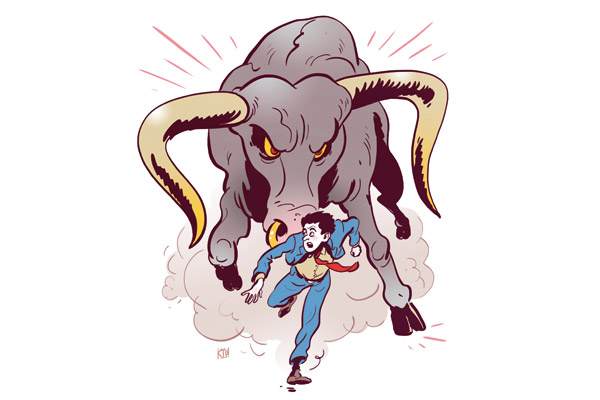I have just finished running — with a thousand like-minded souls from around the world — down a half-mile of medieval city streets while being pursued by a half-dozen half-ton wild Spanish fighting bulls. They were accompanied by an equal number of three-quarter-ton galloping oxen, but we didn’t worry about them: they know the course as well as anyone and keep the bulls in a herd. This is good, because when fighting bulls are on their own they become the beast of solitary splendour and ferocity you may see in bullrings across Spain, France, Portugal, Mexico and much of Latin America. However, every second week in July, during the festival of Saint Fermín, they are run together as a herd from the corrals to the bullring.
Fermín was a 3rd century ad bishop, martyr and patron saint of this city whose feast day of 7 July has been celebrated here since the 12th century, with the addition of bullfighting since the 14th and bull-running since the early 17th. It was not until Ernest Hemingway turned up in the 1920s and told the story of this ‘bull-feast’ — first in dispatches for the Toronto Star and then in his first novel Fiesta — that the English-speaking world came to hear about it.
Returning to this morning’s bulls: they were an interesting bunch, coming all at once in a clumped herd, scything through the Australian backpackers, the clueless American jocks fresh out of college and the drunken stag party from Chester. In amongst all of these young braves (who quickly and sensibly fled to one side or the other) were a hard core of Spanish and Basque runners, and with them an even smaller number of American and British ones.
Some of us looked at the animals, saw no safe opportunity and joined the first-timers lining the walls. Others, meanwhile, took their chances leaping out into the middle of the street to run in among the herd, avoiding horn points, matching foot to hoof at a gallop and trying to find the magical space just in front of a bull. I found just such a space last year, between two bulls: one clearing my path, the other chivvying me along with his horns — part of the wild hunt. My run was not as good as that today — I was out too far in front. I couldn’t see how both to approach and survive.
Why try at all? Well, it may sound like playing to the gallery to talk about the horrors of health-and-safety legislation in the pages of The Spectator, but it’s surely clear to anyone who stops to think that if people are going to be expected to behave like adults, they must be treated as such, and take responsibility for their own lives — even risk them. Which is why I and a brotherhood of friends gather in honour of a saint I don’t believe in and put our lives on the line to pay homage to a set of ideals and a city I passionately do.
Here during the time of Fiesta in Pamplona I see drunkenness but not violence, boldness but not discourtesy and rowdiness but not anarchy (at least as long as Basque and Navarran politics stay out of the mix, as they notably failed to in 1978 and 1997). It is a truism that the crowds at rugby matches are better-mannered than those at football games, but they are twice as polite here in Pamplona. Any insecurities the crowd have are put into perspective as they risk their lives on the streets, often spared only by fate or chance, or — for my Catholic friends — the intervention of Saint Fermín.
I derive what religiosity that I do from running with the bulls themselves; from losing myself among them. After all, men have done this for millennia. Pamplona is less than two hours’ drive from the caves of Altamira, where the oldest art made by early humans (and Neanderthals) depicts men running with 40,000-year-old bulls. These bulls are the aurochs, the giant curving-horned beasts from which modern cattle descend — all 1.3 billion of them, destined to become burgers and shoes.
At least the bulls here, bred to fight in the ring, will have the dignity of taking a shot at their killers — not a fair one, but a shot nonetheless.
This morning I shook the hand of Joe Distler, as I have done on each of the ten mornings I have run, and we wished each other luck. Joe is a retired English lecturer from New York and he has run the bulls more than 300 times in more than 40 years of coming to Pamplona. He’s been trampled, gored, tossed and run over. Today, before we ran, I asked him why he keeps coming back. Here is his answer: ‘Have you heard of Karl Wallenda? He was a great high-wire walker, and when asked why he still dared fate after being seriously hurt he calmly replied, “Walking the wire is life, everything else is just waiting around.” That’s why I run.’
Into the Arena: The World of the Spanish Bullfight is published by Profile Books.






Comments